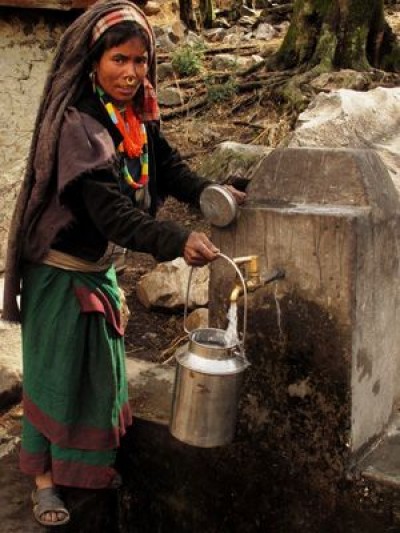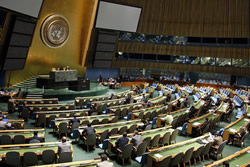Food Aid Brings Fresh Water To Nepalese Village
Food Aid Brings Fresh Water To Nepalese Village
Kanukura, 33, says that carrying water up the mountain slopes to her village used to be the hardest part of her day. It’s a job that mainly fell to women in this part of Nepal, who faced a backbreaking climb when they needed water. But that’s changed now, thanks to a new village tap, from which women like Kanukura can get clean drinking water whenever they need it.

Kanukura used to wake up before dawn and walk for an hour to fetch water for her family. Things changed three years ago when WFP supported a drinking water project for her village. (Copyright WFP/Deepesh Shrestha)
HUMLA – For many years, the women of Mu ndi village in Humla district in western Nepal faced serious hardships when fetching water for their families. The steep, rocky terrain made for hard climbs with heavy pots and buckets from the river bank back to the village.
Now the situation has changed. Three years ago, WFP supported a drinking water project for this rural village. Since then, life has become easier for the villagers – especially the women.
Backbreaking work
“Every day, I used to wake up before dawn and walk for an hour downhill to collect water from the river bank,” says 33-year-old Kanukura Thakulla. “Carrying water-filled pots uphill to reach my home was painful.”
“My head, body and feet used to hurt a lot. Sometimes I would lose my balance and fall to the ground while passing through narrow rocky trails,” Kanukura recalls. “Now life has become so easy. I have water near my house and I can fill my pots and buckets within minutes of turning the tap,” says the mother of three.
To help bring running water to Mundi, WFP launched a project to provide villagers with rice while they worked on a water pipeline. This ensured everyone had enough food to eat while they set aside time to lay down the pipes.
As most of the people who live in the village are farmers, the work was timed to coincide with the period between planting and harvest when farmers can afford to be away from their fields.
Family time
With tap water at her doorstep, Kanukura relates that she is now able to spend more time with her family and quarrels with her husband have also died down.
“On several occasions, I had broken water pots on my way back home. We are a poor family and we don’t have enough money to buy new pots so my husband would scold me every time this happened,” she recalls.
“These days, I don’t break pots anymore and it has contributed in making small savings for us. My husband is also happy and he helps me get water from the tap when I am busy with other household chores,” says Kanukura.
* Deepesh has been WFP’s Public Information Officer in Nepal since March, 2010.
###
About United Nations World Food Programme (WFP)
Fighting hunger worldwide

The World Food Programme is the world’s largest humanitarian agency fighting hunger worldwide.
“In emergencies, we get food to where it is needed, saving the lives of victims of war, civil conflict and natural disasters. After the cause of an emergency has passed, we use food to help communities rebuild their shattered lives.”
WFP is part of the United Nations system and is voluntarily funded.
Born in 1961, WFP pursues a vision of the world in which every man, woman and child has access at all times to the food needed for an active and healthy life. We work towards that vision with our sister UN agencies in Rome — the Food and Agriculture Organization (FAO) and the International Fund for Agricultural Development (IFAD) — as well as other government, UN and NGO partners.
In 2011 we aim to reach more than 90 million people with food assistance in more than 70 countries. Around 10,000 people work for the organization, most of them in remote areas, directly serving the hungry poor.
WFP’s five objectives:
- Save lives and protect livelihoods in emergencies
- Prepare for emergencies
- Restore and rebuild lives after emergencies
- Reduce chronic hunger and undernutrition everywhere
- Strengthen the capacity of countries to reduce hunger
WFP’s Mission statement
WFP is the food aid arm of the United Nations system. Food aid is one of the many instruments that can help to promote food security, which is defined as access of all people at all times to the food needed for an active and healthy life. ¹ The policies governing the use of World Food Programme food aid must be oriented towards the objective of eradicating hunger and poverty. The ultimate objective of food aid should be the elimination of the need for food aid.
Targeted interventions are needed to help to improve the lives of the poorest people – people who, either permanently or during crisis periods, are unable to produce enough food or do not have the resources to otherwise obtain the food that they and their households require for active and healthy lives.
Consistent with its mandate, which also reflects the principle of universality, WFP will continue to:
- use food aid to support economic and social development;
- meet refugee and other emergency food needs, and the associated logistics support; and
- promote world food security in accordance with the recommendations of the United Nations and FAO.
The core policies and strategies that govern WFP activities are to provide food aid:
- to save lives in refugee and other emergency situations;
- to improve the nutrition and quality of life of the most vulnerable people at critical times in their lives; and
- to help build assets and promote the self-reliance of poor people and communities, particularly through labour-intensive works programmes.
###
> United Nations (UN).
 The United Nations was established on 24 October 1945 by 51 countries committed to preserving peace through international cooperation and collective security. Today, nearly every nation in the world belongs to the UN: membership totals 192 countries.
The United Nations was established on 24 October 1945 by 51 countries committed to preserving peace through international cooperation and collective security. Today, nearly every nation in the world belongs to the UN: membership totals 192 countries.
When States become Members of the United Nations, they agree to accept the obligations of the UN Charter, an international treaty that sets out basic principles of international relations. According to the Charter, the UN has four purposes:
- to maintain international peace and security;
- to develop friendly relations among nations;
- to cooperate in solving international problems and in promoting respect for human rights;
- and to be a centre for harmonizing the actions of nations.
###
* The above story is adapted from materials provided by United Nations (UN)
** More information at United Nations (UN)




















